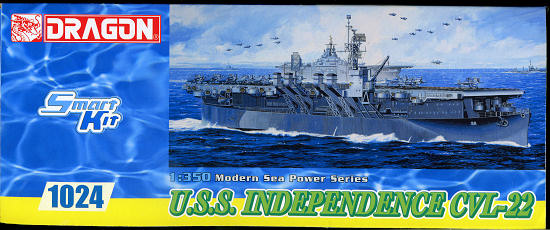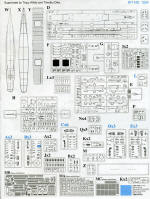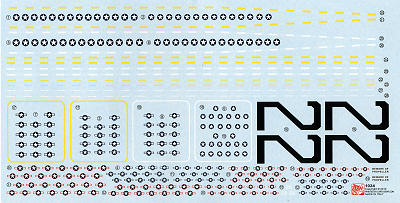
| KIT #: | 1024 |
| PRICE: | $165.00 MSRP |
| DECALS: | Three options |
| REVIEWER: | Scott Van Aken |
| NOTES: | New mold kit |

| HISTORY |
Begun as light cruiser Amsterdam, CL-59, she was launched as CV-22 on 22 August 1942 by New York Shipbuilding Corporation, Camden, New Jersey, sponsored by Mrs. Rawleigh Warner, and commissioned 14 January 1943, Captain G. R. Fairlamb, Jr., in command.
The first of a new class of carriers converted from cruiser hulls, Independence conducted shakedown training in the Caribbean. She then steamed through the Panama Canal to join the Pacific Fleet, arriving San Francisco 3 July 1943.Independence got underway for Pearl Harbor 14 July, and after 2 weeks of vital training exercises sailed with carriers Essex (CV-9) and Yorktown (CV-10) for a devastating raid on Marcus Island. Planes from the carrier force struck 1 September and destroyed over 70 percent of the installations on the island. The carrier began her next operation, a similar strike against Wake Island 5 October to 6 October as CVL-22, having been redesignated 15 July 1943.
She then went on to have a distinguished wartime career. Post war Independence joined the Operation Magic Carpet fleet beginning 15 November 1945, transporting veterans back to the United States until arriving at San Francisco once more 28 January 1946. Assigned as a target vessel for the Bikini atomic bomb tests, she was placed within one-half mile of ground zero for the 1 July explosion. The veteran ship did not sink, however (though her funnels and island were crumpled by the blast), and after taking part in another explosion 25 July was taken to Kwajalein and decommissioned 28 August 1946. The highly radioactive hulk was later taken to Pearl Harbor and San Francisco for further tests and was finally scuttled off the coast of San Francisco, California, on 29 January 1951. Controversy has subsequently arisen about the sinking of the Independence, as it is claimed she was loaded with barrels of radioactive waste at the time of her sinking, and that the waste has subsequently contaminated the wildlife refuge and commercial fisheries associated with the Farallon Islands.
Independence received eight battle stars for World War II service.
| THE KIT |
 Dragon Models has one again provided the ship enthusiast with a superb kit. Totaling over 1300 parts, this is by no means a quick build, however, many of the parts total comes from duplicate sprues for things like guns, rafts, aircraft and other multiple items. I was particularly impressed that the aircraft were segregated by a cardboard wall from the rest of the kit. The major hull pieces and deck were also well protected in a form-fitting clear vacuformed tray to keep them from being loose in the box and damaging other sprues.
Dragon Models has one again provided the ship enthusiast with a superb kit. Totaling over 1300 parts, this is by no means a quick build, however, many of the parts total comes from duplicate sprues for things like guns, rafts, aircraft and other multiple items. I was particularly impressed that the aircraft were segregated by a cardboard wall from the rest of the kit. The major hull pieces and deck were also well protected in a form-fitting clear vacuformed tray to keep them from being loose in the box and damaging other sprues.
Though it very much appears to be a full hull model, complete with base, it also seems like one could leave off the lower hull section and do this one as a waterline. The kit comes with a full complement of weapons and one can do the early shakedown version with the 3 inch guns (that is what they look like to me) or its combat version where those were replaced by what appear to be quad 40mm anti-aircraft guns.
The kit has three very nicely done photo etch frets that include radar antennas, railings, catch nets, seats and sights for the AA guns, and many other small detail parts. No need for aftermarket for this one. You also get six each aircraft for the air wing, including SBDs, TBDs and F6Fs. The Avengers and Hellcats come with three aircraft that have folded wings and three that have them extended. Even the simplest aircraft has 13 parts with the most complex at 20, so this does add to the parts count. The kit includes hangar deck detail as well and you can pose the elevators either raised or lowered.
In addition to the bits specifically for the shakedown cruise, there are parts differences for the Marcus Island and Rabaul raids of 1943. The instructions point this out quite clearly so you'll need to keep this in mind while building. The kit decal sheet is very large and well printed, providing different markings options for the three different builds as there were subtle and not so subtle differences in terms of deck markings. This extends to the aircraft with markings for the early blue-grey over light gull grey camouflage and the later tri-color camouflage as well. For the latter, you can do either blue or red surround insignia as were used from June to September of 1943.
markings options for the three different builds as there were subtle and not so subtle differences in terms of deck markings. This extends to the aircraft with markings for the early blue-grey over light gull grey camouflage and the later tri-color camouflage as well. For the latter, you can do either blue or red surround insignia as were used from June to September of 1943.
Speaking of instructions, those are superbly done with 10 major construction steps, most of which are made up of smaller sub-assembly steps. This includes the aircraft markings and assembly as well as the painting of the figures. The kit provides 18 deck figures in styrene as well as six vehicles (two trucks and four tow tractors) to add a bit of additional life to your ship.
| CONCLUSIONS |
In all, a truly outstanding model of this very important light carrier. If you love doing 1/350 ships and didn't have room for one of the Essex carriers from Trumpeter, you can now do something smaller and better detailed.
| REFERENCES |
http://en.wikipedia.org/wiki/USS_Independence_%28CVL-22%29
December 2010 Thanks towww.dragonmodelsusa.com for the preview kit. Get yours today at your local shop or on-line retailer. If you would like your product reviewed fairly and fairly quickly, please contact the editor or see other details in the Note to Contributors.